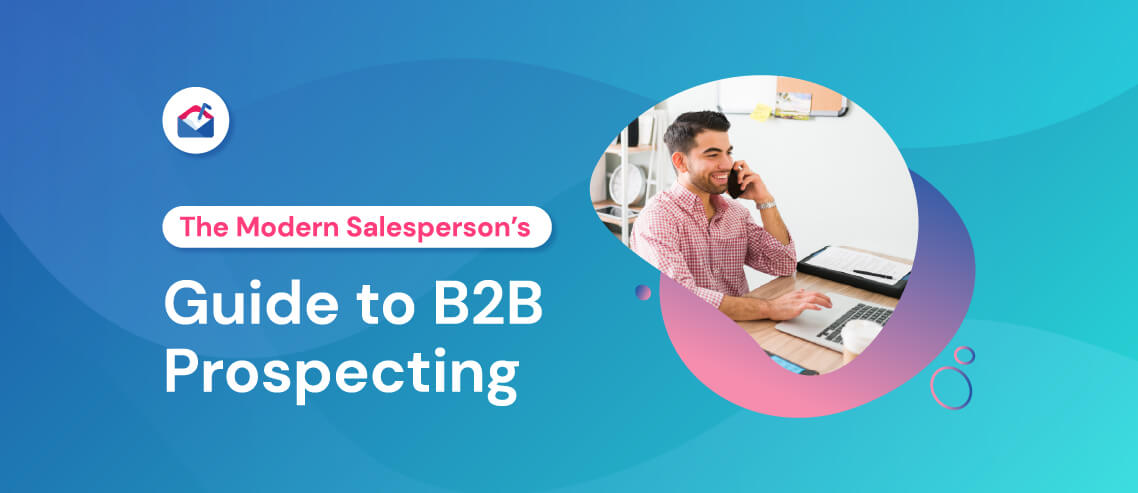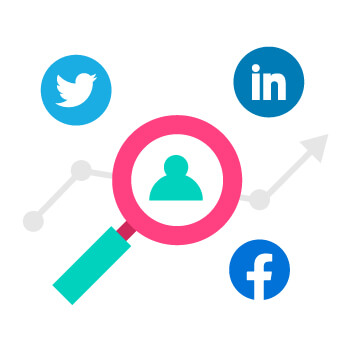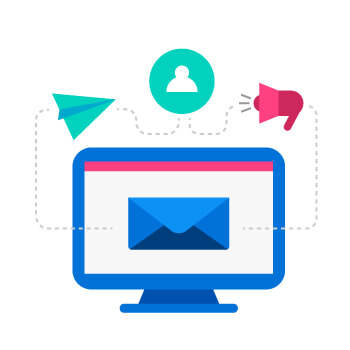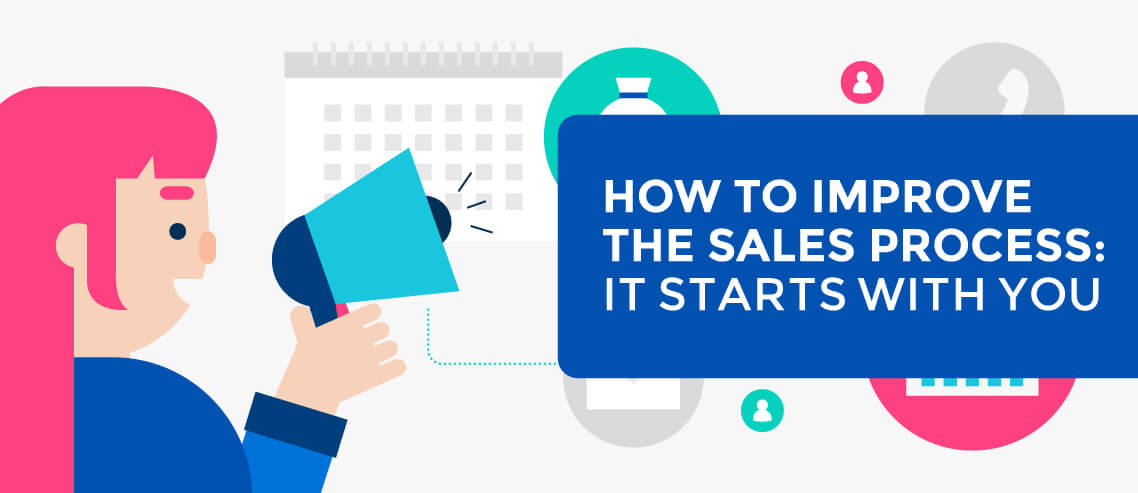The Modern Salesperson’s Guide to B2B Prospecting

Contents
B2B prospecting is one of the most critical parts of the sales process – without a steady stream of prospects, you have no opportunities to create revenue. It’s also one of the most difficult, with more than 40% of salespeople claiming that B2B prospecting is their biggest challenge, followed by closing (36%) and qualifying (22%).
Overcoming struggles with B2B prospecting is arguably the most important priority in sales organizations. HubSpot Research found that 72% of companies with less than 50 new opportunities per month didn’t achieve their revenue goals, compared to 15% for companies with 51-100 new opportunities, and just 4% for companies with 101-200 new opportunities.
There are some hard skills that are essential for sales development reps and salespeople in any industry to have a firm grasp on. You can build on top of these skills for your particular industry or company, but knowing the basics and how to implement them effectively is absolutely essential.
Here’s a closer look at how to improve the way you prospect, and ultimately the results you earn.
Finding Qualified Prospects
B2B prospecting works best when you have a clear vision of the kind of client you’re looking for. The qualified prospect is an intersection of three criteria:
- The client sees value in what you do
- The client has the budget to pay for what you do
- You have the confidence that you can deliver good results to the client
Think of each of these as a leg of a three-legged chair: take away one leg and the chair isn’t functional.
So, where do you find qualified prospects that meet each of these three criteria? The following resources can be helpful both in learning more about what your ideal prospect looks like, and in connecting with them on the spot:
For many, social selling via LinkedIn has become the preferred way of connecting with prospects. Because it’s geared toward the professional, not the casual user, you can use the network to find prospects by industry or job title, learn more about them through the content they post, and use mutual connections to get an “in.”
Here are a few best practices you can use to sort through the 575 million users:
Job Title/Demographic Search
Use LinkedIn’s basic search feature to find prospects by job title, company, or industry. This gives you a direct connection to decision-makers or influencers without the hassle of cold calling.
Advanced Keyword Search
You can leverage LinkedIn’s advanced search features to fine-tune your scope. Use the People Filters when you search for a keyword to narrow your search results. Also, you can use Boolean filter words like AND, OR, or NOT to include or exclude certain terms, or put phrases in quotation marks to get exact matches.
LinkedIn Groups
LinkedIn Groups connect you to user bases that share common characteristics, interests, or goals. Click the ‘Work’ icon on your LinkedIn home page, select ‘Groups’, then click ‘Discover’ to see suggested groups. You can request to join to get access to users within a group.
The “People Also Viewed” Sidebar
This feature is like a shortcut to cloning your ideal customers. Go to the profile of one of your best customers, then look at the right-hand sidebar to see similar users. Your one prospect has now become several.
Other Social Media Channels
Facebook and Twitter provide valuable B2B prospecting opportunities, but the process isn’t as direct. These tools are largely used to build familiarity and trust, so make these objectives a priority when reaching out to users.
A few best practices for each:
Your main focus here should be to optimize your personal profile. Ideally, you’ll open your profile for public view so people you reach out to can get to know the real you. You want to present your human side, not a corporate entity, but at the same time you also want to highlight your professionalism.
Curating content from industry resources is the easiest way to do both. You’re showcasing your expertise without packing your feed with sales messages.
Like LinkedIn’s, Facebook Groups can be an effective tool for finding prospects that share similar needs or characteristics. Request to join groups, but make sure you follow the group’s rules so you don’t get removed.
A strong bio is essential for Twitter prospecting. Like Facebook, you want to show your human side and not just your corporate role, but you also want to emphasize your expertise.
The best way to do this is to follow influencers in your industry (and hopefully they’ll follow you back), share their content, and use retweets to start conversations.
Tools and Platforms
Like Apple’s “There’s an app for that” iPhone campaign, there’s a tool or platform for just about any piece of your sales process, including B2B prospecting. Take a look at a few of the most popular tools and how they supercharge your prospecting efforts:
LeadFuze
This lead gen software uses AI to find leads in specific roles or industries on your behalf. You tell it your criteria, then LeadFuze crawls the web to find matching prospects and their contact information. It’s an automatic process once you get it set up, removing much of the labor-intensive, time-consuming aspect of B2B prospecting.
CrunchBase
If you’re focused on contacts based on company rather than by role, CrunchBase is a powerful B2B prospecting tool. The platform discovers company data that fits your ideal client (particularly in terms of funding and investment data), then works to gather names and contact information so you can start connecting.
BuiltWith
BuiltWith is a unique approach to lead gen that dissects the individual components of websites, such as shopping carts, hosting, and other tech. The platform looks at nearly 35,000 internet technology trends so you can learn more about your prospect’s platform before you talk to them.
Other Places to Find Prospects
Finding qualified B2B prospects takes a certain level of creativity beyond the obvious social media and lead gen tools. If you have an eagle eye for prospecting, use these outside-the-box resources that are teeming with potential:
Online Communities
Sites like GrowthHackers and Reddit bring like-minded users together to share and grow. If you’re not sure which communities to join, just ask your best customers which ones they’re members of.
Software Review Sites
Review sites like Capterra, G2Crowd, Get App, and ProductHunt are user-driven, which gives you direct insight into what makes them tick. Read reviews to find prospects’ pain points and what they need and want in software solutions, then reach out with how you can help.
Local Chambers of Commerce
Don’t neglect the physical world around you when it comes to B2B prospecting. Your local Chamber of Commerce can be a valuable place for networking and discovering new businesses in your area.
Industry Conferences
Industry conferences are prime for B2B prospecting. Attendees are interested in the topic at large, while the speakers are experts in the industry. Buy lists if they’re available so you can reach out before and after the conference.
Industry Trade Publications
Comb through industry trade publications to find contributors and advertisers that fit your ideal profile. Not only are these prospects likely qualified, but you can also use the publication as a talking point to build rapport.
Tech News Announcements
Mashable and TechCrunch are go-tos for tech news announcements. Sign up for updates or press releases to learn about who’s who in specific industries.
Business Associations
Partner with professional business associations to boost your networking. Not only will you get to attend events, but you may also get a member list for B2B prospecting.
Alumni Groups
Your alma mater gives you more than an education. Use LinkedIn’s Alumni Groups to connect with prospects from your college or university.
Charitable Organizations
Rotary, Kiwanis, and other charitable organizations can help you promote yourself within the community and build positive PR in the process.
Finding Reliable Contact Info
You need more than just a name for B2B prospecting, especially if you want to bypass gatekeepers and go straight to the source.
Tools to Use
The biggest benefit of using tools is to remove much of the labor and guesswork. If you’re looking for email addresses, VoilaNorbert offers a cost-effective solution with up to a 98% success rate. Norbert can also find the current job title, company, location and social profiles of the people on your list.
Zabasearch is a powerful, free people database that specializes in searches by name or phone number. Other tools like Clearbit, Zoominfo, DiscoverOrg, InsideView, Datanyze, Nimble, and Adapt can also help you connect directly to decision-makers, not just the front desk.
Manual Ways to Find Contact Info
If you’re worried about the reliability of data tools, you can do your own recon to find the most recent phone numbers and email addresses.
Start with advanced Google search operators, such as site:twitter.com + name + company name. This extra detail gives you super-specific results quickly.
You can also look up personal information on a prospect’s Facebook profile, or call their company directly to get a direct phone number or extension. Or, if you have shared contacts on LinkedIn, leverage your network for an introduction.
Reaching Out to B2B Prospects
There’s no single best approach to sales prospecting, even within your own organization. Successful sales prospecting typically uses a multifaceted methodology to connect with potential customers and keep your opportunity numbers high.
Ideally, you need to be doing a combination of cold emailing, cold calling, and social media outreach to effectively connect with prospects. Put the following best practices in each of these categories into motion to avoid leaving gaps in communication.
Cold Email Best Practices
Cold emails are multidimensional tools on their own. From the subject line to the call to action, effective email outreach relies on what you send, when you send it, and how often you send it.
Let’s break it down piece by piece:
Subject Lines
David Ogilvy famously said that your headline is 80 cents out of your dollar. Your subject line is your headline, so make it count. Remember, 47% of people will open your email based solely on the subject line.
Your subject line has stiff competition in the inbox, especially since your prospect doesn’t know you. You must be clear and direct about your email’s content and give them a reason to open it. For example, if you’re trying to increase attendees for a class, you might include the words ‘Academy’ or ‘Masterclass’ in the subject line, followed by a brief description.
If you want to increase familiarity with your prospect, consider following them on Twitter or visiting their LinkedIn profile prior to sending the email so they’ll be able to see your name and face beforehand.
Structure
Using templates takes the guesswork out of composing a cold email. The most basic template includes a subject line, greeting, concise message, CTA, and all of your contact information in the signature. Tailor your templates for the initial email and follow-up messages for maximum impact.
Calls to Action
If you don’t ask, you won’t receive. Every email should be actionable, whether you want them to schedule a demo or click through to a blog post. Make the next step clear and easy to take advantage of.
Follow-Up
Average email open rates can vary from 15.22% to 28.46%, depending on the industry. This means that the majority of people you email won’t respond the first time. You know that follow up is important, but knowing how often to follow up is paramount.
The exact number depends on several factors. For example, Sales Hacker CEO Max Altshuler uses a four-email sales cadence (initial email plus three follow-up emails) that follows a predictable structure.
Effective follow-up emails are focused efforts to move the conversation forward. For example, you might share a recent blog post that could help them solve a problem. You want to stay top-of-mind without overextending your welcome in their inbox.
If you’ve gotten an initial response but seem to be stalling, ask them when the best time would be to hop on a call. Or, if you’re not getting a response at all, combine your email outreach with other touchpoints. If they’re tuning you out regardless of channel, send a final message designed to get a “No” so you can move on.
Email Automation
Automating cold emails can free up your salespeople to focus on existing pipeline deals while still trying to fill the funnel.
If you rely on automation, make sure your prospects come out of sequence if they engage. The last thing you want is to send them a no-response follow-up email if they’ve already moved to the next stage of your funnel.
Retargeting
Retargeting campaigns can help you stay top-of-mind without having to engage in emails. If the prospect visits your website, retargeting can advertise on your behalf as they browse.
Cold Call Best Practices
Cold calling is one of the most nerve-wracking experiences for salespeople, but knowing how effective it is should put your mind at ease. In fact, 41.2% of salespeople said their phone is the most effective sales tool at their disposal.
Here are a few quick tips for conquering the cold call:
- Improve your voice and tone by standing up and smiling when you cold call
- Practice with a friend
- Call your least qualified prospects first to help you get used to rejection
- Test cold calling at different times and gauge response rates
- Leave voicemails and let prospects know you’ll call again
- Rely on short, simple scripts to sound confident and knowledgeable
- Rewrite these scripts as you learn what works and what doesn’t
- Always follow up
Keep in mind that it takes an average of 18 calls to connect with a buyer and the average sale requires five follow-up calls. Over 80% of calls will go to voicemail, and 90% of first-time voicemails are never returned, so don’t take silence as an answer.
Social Media Best Practices
Social media is like the cocktail party of B2B prospecting. You want to present yourself as an influential authority people want to get to know without coming across as intimidating or self-interested. You can achieve this persona in a number of ways.
First, optimize your LinkedIn and Twitter bios for selling so there’s no question about what you do. Make sure you remain active on your social media channels to show you’re an interested, knowledgeable member of the group you’re selling to.
Participate in communities to establish yourself as an expert. It’s easier to stand out in smaller communities to increase your visibility, so don’t just set your sights on the most popular groups.
Take every opportunity to share useful content with your audience, whether it’s a guest post you wrote or something from an industry expert. This helps you to build your authority as a credible source. You should also collect testimonials and other social proof to highlight your skills.
If you’re using direct connections like InMail or Twitter, personalize your message and make it specific and memorable. For example, you might reference other content you’ve shared with them, retweet something they posted, or mention something that mutually connects you.
Putting It All Together
Sales prospecting has a lot of moving parts, and they need to work together flawlessly if you want to see the best results.
Set up a cadence using all three outreach techniques with at least six touchpoints. Split test different elements to maximize each component’s performance.
And don’t forget to revisit it as you learn more about your prospects so you can win bigger over time.





